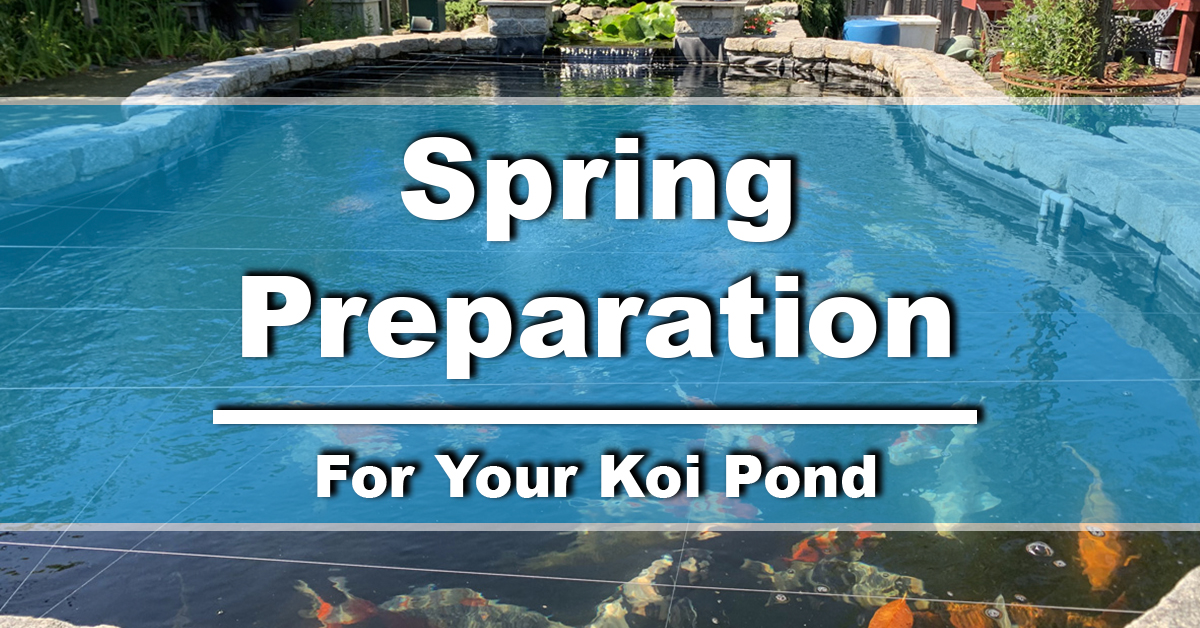
Learn our recommended tips and tools for Koi pond owners to follow for spring pond opening.
Spring Koi Pond Maintenance is the most dangerous time for your Koi. If you do it wrong, your Koi can get sick. If you do it right, they will thank you; and you will enjoy the rest of the Koi season with peace of mind. Our Koi Pond Preparation Checklist ensures you cover every essential step during Spring Pond Cleaning. We have over 50+ years caring for high-quality Japanese koi and have raised many Koi Grand Champions.
Please ask us any other questions you have in the comments section or visit one of our Kodama Koi & pond supply retail stores for more information. If you are looking to shop online you can also Buy Live Koi Fish Online from our farm in Hawaii to add that extra sparkle to your pond this year.
Table Of Contents – Spring Pond Opening Tips:
- Monitor water temperature
- Treat the whole pond
- Activate your filter
- Be patient in feeding
- Pond cleaning
Learn more about how to choose koi for pond in this educational article.
WATCH – Spring Pond Prep Tips for Opening a Successful Season
5 Tips for Opening Pond in Spring
1. Monitor Pond Water Temperature
This is very important. Please don’t do anything until the water temperature is stable from 50–55 F. I am still surprised to know how many people do not have a floating pond thermometer in their ponds. Koi are cold-blooded animals. In other words, they cannot control their body temperature; rather the environment or water temperature, in this case, determines Koi’s body temperature and controls their behavior.
Knowing water temperature is essential throughout the season because it guides us on what to do, especially at the beginning of the season. If you do not have a thermometer, please buy one. You can buy an inexpensive one or something like a Seneye Pond Pack that shows the temperature on your smartphone.
It is also a good idea to check basic water quality testing parameters at the same time. Please check at least pH, Ammonia and nitrate levels, Nitrite, and Alkalinity. Make sure your pond maintains the healthy environment for your Koi.
2. Treat Your Koi Pond
Once the water temperature is stable around 50–55F, your Koi will be active and start looking for food. BUT wait. You cannot feed them yet.
After long fasting season, Koi are weak. Their immune systems are very low. We need to take care of any potential parasitic and bacterial issues first. If parasites are in your pond system, they will attach to your Koi before they are active and ready. I usually recommend Terminate (or Proform C) and Koi Prazi because they stop most parasite problems. I recommend these treatments at a season’s beginning and end—only twice a year. Koizyme is also an excellent product to prevent bacteria issues. It is not a chemical (that is why I like it). It is beneficial bacteria that naturally eliminates bad bacteria like Aeromonous or Pseudomonous and minimizes the risk of ulcer problems in your pond.
Using koi clay will also help reduce diseases. Before you use any medicines, please make sure you know the total gallons of your pond. You don’t want to overdose or underdose the medicines for your Koi.
3. Activate Your Filter / Clean Filter
Are you using mechanical filter (beads filter) or biological filters? Either way, if you stop your filters during the winter, you need to restart the nitrogen cycle. Please clean inside the pond filter. If there is any water or wastes left, please drain them all out and clean the filter. Once you clean it, please run your filter.
Here is an important step: Add beneficial bacteria to your Koi filter or pond. After winter, you have little bacteria to help establish the nitrogen cycle. So we need to seed the bacteria. While there are many products of beneficial bacteria online, my personal recommendation is Niigata Water Bio Balls. It has been a popular Koi pond product in Japan for the last 30 years. Each small tablet contains around 20 billion bacteria and their food to multiply themselves. Since these bacteria can live in temperatures as low as 41 F, this is a perfect product for spring—when water temperature is still unstable, but we want to establish the cycle as soon as possible.
If you are fortunate to live where water temperatures are over 50 F even in winter, you probably do not stop your filter and can feed your Koi lightly.
In this case, you do not have to clean your filter. But adding Niigata Water Bio is recommended to boost the nitrogen cycle. “I’ve always found that preparing your koi pond filter system properly in the Spring is one of the most important factors for a successful season.” – Koi Hobbyist – Chase Ohlson Freelance Web Developer in Los Angeles
4. Be Patient in Feeding in Spring
Feed the right food and right amount at the right pace. We all enjoy feeding our Koi. That is the best part of the hobby. However, please do not rush to feed them yet.
Although the water temperature may be good and your filter activated, your Koi are not as ready as you are. They are just coming out of a long fasting season. They are hungry, but their bodies’ systems are not ready to eat normal food. When we are weak from sickness, we eat something soft like chicken noodle soup, don’t we? Your Koi need to start with something soft, digestible, and nutritious.
What do we feed the Koi? Some people soak pellets with water and feed their koi that. That is good, but it could cloud your pond water. Many people love Manda Fu Koi Food. No other Koi food can beat 98.2% digestion rate of Manda Fu. Because of its digestibility, this food can also be fed in water temperatures as low as 45 F. Being digestible is only one feature of Manda Fu. A nutritious enzyme called Manda Nishiki is injected in the food so that Koi can eat digestible and nutritious food in spring.
How often do we feed them? We cannot rush. For water temperatures between 50–55 F, feed Manda Fu once every few days as it gets warmer. Then for 55 F and up, feed regular food like Kodama Koi Food All Season; and start with once a day. Please read our detailed koi feeding guide for more details.
5. Koi Pond Cleaning for Spring
Some people have rocks at the bottom of their ponds. If you are one of them, you may need to move your Koi temporarily and clean the pond even before you start treating and feeding your Koi. Otherwise, debris between rocks will create issues and affect water quality and your Koi’s health.
I do not recommend rocks in Koi ponds because you have to move and stress your Koi almost every year; and they harbor a source of potential Koi health issues. If you must leave the rocks in this year, please do so. But I recommend you consider removing all the rocks from your Koi pond at this time.
Ensure that you take your time in debris removal and be vigilant on clearing string algae within your algae bloom prevention methods. Regular pond vacuuming will also help eliminate stubborn debris.
Keep all these tips in mind to help your Koi have a safe spring. And enjoy this wonderful Koi season.
Our Recommended Koi Care Products For Spring Pond Opening
We hope these items help you have a fun and stress free pond opening in your koi pond. Remember to keep that water healthy and check your parameters often! Thanks for reading.
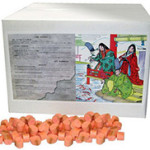 Manda Fu Koi Food To add extra enjoyment to your time feeding koi, keep Manda Fu in your hand for easy petting. In the summertime, your koi will love this as a treat.
Manda Fu Koi Food To add extra enjoyment to your time feeding koi, keep Manda Fu in your hand for easy petting. In the summertime, your koi will love this as a treat.
It is also suitable for autumn, winter and spring. You can feed when the water temperature drops as low as 45°F to 50°F. Buy Manda Fu Koi Food
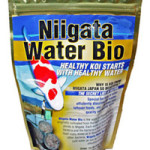 Niigata Water Bio Balls One tablet contains about 20 billion bacteria and the bacterias’ food.
Niigata Water Bio Balls One tablet contains about 20 billion bacteria and the bacterias’ food.
These bacteria help filtration and dissolve upon contact with water while multiplying the bacteria to help remove Koi waste, leftover food, and other debris.
They can live in water temperatures as low as 41F degrees (5c degrees). It is best to dissolve the tablet in a bucket of water before pouring it into the pond. Buy Niigata Water Bio – Filtration Bacteria
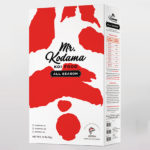 Kodama Koi Food – All Season (Wheat Germ) Kodama Koi Food – All Season/Wheat Germ is best for maximum koi growth and health, and its digestibility will allow you to feed your koi all year round.
Kodama Koi Food – All Season (Wheat Germ) Kodama Koi Food – All Season/Wheat Germ is best for maximum koi growth and health, and its digestibility will allow you to feed your koi all year round.
Wheat germ oil is widely known and used as human health food. The remaining defatted wheat germ is used as an ingredient for koi food. Kodama Koi Food, uses the FRESH wheat germ before the oil is extracted.
This keeps your koi healthy and improves its beautiful skin. Bio Stone with silicon aluminum is added to not only keep koi healthy but also helps maintain good water quality by absorbing ammonia. Buy Kodama Koi Food – All Season Wheat Germ
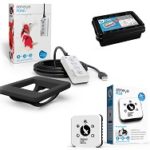 Seneye USB Pond Monitoring Pack The Seneye USB Pond Pack monitors your pond’s vital stats and alerts you if its levels go off balance so you can take action.
Seneye USB Pond Monitoring Pack The Seneye USB Pond Pack monitors your pond’s vital stats and alerts you if its levels go off balance so you can take action.
This guards your koi from ammonia poisoning and extreme swings in pH levels and water temperature. You’ll be able to remotely view your pond’s parameters on a PC or smartphone from anywhere in the world (or your living room couch) with an Internet connection. Buy Seneye USB Pond Monitoring Pack
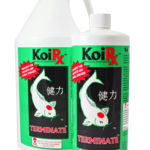 TERMINATE Specially formulated treatment for salt resistant parasites and fungal disease!
TERMINATE Specially formulated treatment for salt resistant parasites and fungal disease!
Strains of salt-resistant koi pond parasites, like costia and trichodina are becoming more common every day.
TERMINATE is specially formulated to treat these tough salt resistant parasites. TERMINATE is one of the most effective Malachite Green (chloride) & Formalin products on the market. Safe for treating costia, chilodonella, ich, oodinium and fungal infections Buy Terminate
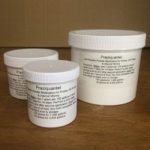 Koi Prazi Praziquantel is used for the treatment of worms.
Koi Prazi Praziquantel is used for the treatment of worms.
Flukes (gill and body) are a parasitic worms. Many times when the koi are flashing or you have new koi in the quarantine, they will have flukes.
Koi Prazi is 100% Praziquantel with zero additives; thus giving the best possible rate of absorption into the pond. No additives or fillers are used. When you suspect that your koi may have flukes, then Koi Prazi or Aqua Prazi is the choice. Buy Koi Prazi
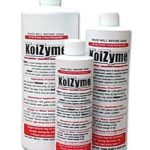 KoiZyme KoiZyme is a biological formula of naturally occurring bacteria, enzymes, and micro nutrients. When KoiZyme is introduced into pond water that is infected with Aeromonas, Pseudomonas or any gram negative or gram positive bacteria, the bacteria and enzymes in KoiZyme competes with these pathogens for the nutrients in the pond water.
KoiZyme KoiZyme is a biological formula of naturally occurring bacteria, enzymes, and micro nutrients. When KoiZyme is introduced into pond water that is infected with Aeromonas, Pseudomonas or any gram negative or gram positive bacteria, the bacteria and enzymes in KoiZyme competes with these pathogens for the nutrients in the pond water.
These nutrients are primarily a nitrogen based nutrient from fish waste. KoiZyme will consume these nutrients and thus starve Aeromonas and Psuedomonas. The bacteria counts (CFU’s) of these pathogens will then be reduced to such a low level that they will not have an effect on your fish. Buy KoiZyme
Further Reading About Koi
Read this other article for more specific tips on opening all types of ponds in the spring from Nualgi Ponds and pond water quality expert Christian Shostle. He goes on to mention the importance of koi clay in your pond for happy healthy fish. Which is another great topic for you to read later!
Essential Pond Care for Cold Weather; Pond Winterization
As summer fades and fall takes over, we still got you covered. Winter pond care quickly becomes a priority with snow on the horizon. As temperatures drop, proper koi pond winterization is essential to ensure your beloved Koi remain healthy and safe.
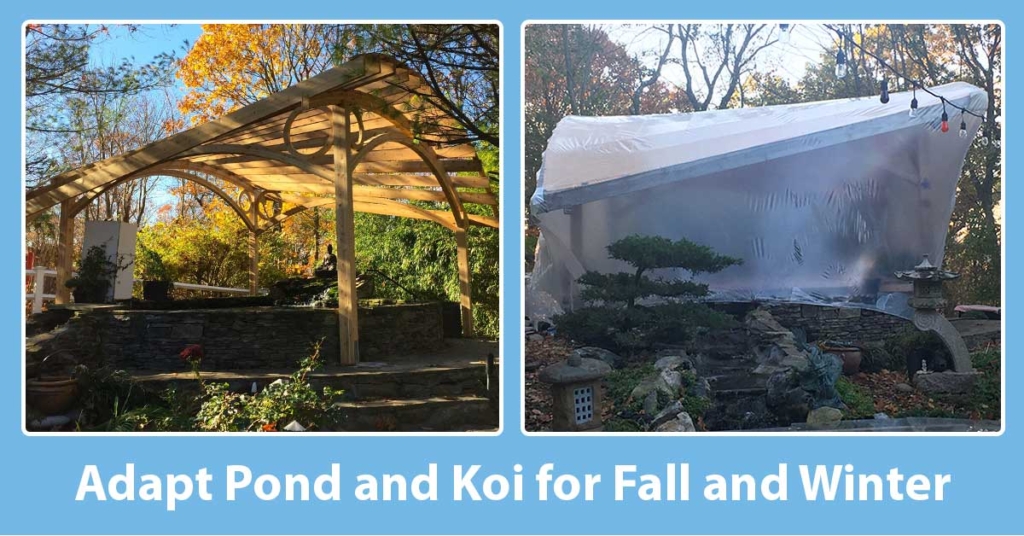
Read our blogpost about ” Koi Pond in Winter: Best Tips for Winter Koi Pond Preparation “




When and how much salt to add to your pond.
Hello
We usually put salt when Koi seems to be stressed like right after the arrival.
You can start with 3lb/100 gallons.
What kind of salt you use?
Hi, I bought a house with a small pond with a waterfall. The previous owners had fish in there but said they’d removed them. It’s been 6 months and when I was raking leaves I noticed movement, a goldfish or koi!!! So he’s been on his own all this time. No filter running, no extra food. I had no idea he was there. Should I clean the pond now? Or in spring? He’s super active.
Hello, without seeing the pond, it is hard to answer your questions. But if it was the only fish and it has survived until now, it should be OK until Spring. I would wait until Spring.
It’s very important to use pond salt- NOT table salt.
Best to buy a salinity tester and measure the level to .3% also please dissolve the salt first in a bucket with a pump and pour it into the pond away from koi. Try not to go up more than .1% per day. Then after 3-5 days you can bring down the salt content through water changes.
You can go as high as .6% for a day or two but don’t do it unless you suspect your fish are sick. It’s hard on the kidneys but will kill salt resistant organisms. .3% is a healthy level but only for short time. Don’t leave it that way for more than a week.
Enjoy
Our Recommended Koi Care Products For Spring Pond Opening We hope these items help you have a fun and stress free pond opening in your koi pond.———— is the best choice for your pond.
So I got my salt back down to .05 as directed can I add proform c and prazi at same time cause profile says daily water changes for 3 days won’t I lose the prazi med also when can I begin to add salt again after treatment
I usually recommend 1) finish Proform C/Terminate for the first 3 days. 2) Use Koi prazi after that
I put Praziquantel in my pond 2 days ago…how long should I wait before using the Proform c..? A week? Thanks
I usually recommend 2 treatment of Prazi with 10 days apart. If you put Prazi 2 weeks ago, it is time to put another and wait for a week before you put Terminate or Proform C
Thank you for all your wonderful articles, they have helped me a lot
I am just using recycled filter media and live plants for my filtration system so far no problem at all my koi fish are happy
The day time temp is 50 to 60 and night is dropping in the 30’s at night. the fish are becoming active. when can i start feeding them? also when can i take them out and clean the pond?Thank you.
Thank you for the question. When the water temperature is stable at 50F. I recommend you start Manda Fu. Once it hits 55F, you switch to all season food like Kodama Koi Food.
About cleaning pond, do you have gravels at the bottom of your pond? is it why you feel you need to take Koi out? If it is just liner or concrete pond with no gravels, I do not think you need to take them out
When you treat with proform c/prazi in spring, do a one day treatment or proform c every dayx3 days, and prazi last day??
Hi Anthony, Here is what I usually suggest. Proform C or Terminate need daily treatment 3 times. So
Day 1 Proform C / Terminate
Day 2 25% water change & Proform C or Terminate
Day 3 25% water change & Proform C or Terminate AND Prazi
Day 13 One more treatment with Prazi
When should I start koizyme in this process?
Hi just read the above comment and reply about ProForm C. Are you saying no water change is necessary on the 1st day of treatment? I thought you had to remove water each time. Thanks in advance!
Hi Tammy,
Before the 1st introduction of Proform C? I do not think so, but I do not think it is a bad idea either. According to the instruction, in my understanding, we need to remove 25% water before 2nd and 3rd treatments of Proform C.
Thanks so much! I think we will change each of the 3 treatments just to be safe !
Thank you for this very useful and informal article. I will be sending clients here to learn the proper procedures to opening there pond in the spring. Also feel free to check out koipondwatergardencolorado for endless information and ideas on koi ponds and water features. Thanks
Thank you
I need to top off a small koi pond. The temp of the pond water is 50. The tap water is 64. Is that a problem?
Adding warmer water should not be problem. but if you add tap water, please make sure you use dechlorinator such as https://www.kodamakoisupply.com/cloram-x-water-conditioner/
I think it is OK if water gets warmer. If water gets colder, I would not recommend
I respect everything that you have written in this blog. Please continue to provide wisdom to more people like me.
Hi and thank you for a nice article. I had a couple of easy questions
1. Proform C instructions notes not to use for salt, but i heard that one should add salt to get a 0.1-0.25% salt concentration. How long should i wait to add salt after treatment?
2. It is a pain in the neck for me to get media out of the filter—do you have a vacuum or apparatus you can suggest to help?
3. Is there a filter media you suggest for NYC are koi pods?
4. I am going to buy my supplies this year from your affiliated website. Do you have lists of equivalent products for the chemicals, beneficial bacteria and treatments you suggest?
Hi, Thank you.
Here are my responses.
1) It is probably the best to ask the manufacturer. But after the last 25% water change, I usually wait 1 day before I add salt.
2) It depends on what kind of filter or filter media you are using.
3) What type of filter media to use depends on what kind of space and set up you have for your pond
4) Thank you. Each product has its own purpose to serve. If you have
– Koi Prazi https://www.kodamakoisupply.com/shop/koi-prazi/
– Terminate or Proform C https://www.kodamakoisupply.com/shop/terminate/
– Niigata Water Bio https://www.kodamakoisupply.com/shop/niigata-water-bio/
– Ultimate (if you use city water) https://www.kodamakoisupply.com/shop/ultimate-water-conditioner/
– KoiZyme https://www.kodamakoisupply.com/shop/koizyme/
if you have the above, they should cover almost all
One more question: Does the below seem like a reasonable schedule
DAY 0: Start one a week Mandy Fu when water >45 degrees until >55 degrees
Once water hits 50-55 degrees…..
Day 1: Add 1st Dose of Koi Prazi
Day 7: 1st Proform-C or Terminate Top-off water
Day 8: Exchange 25% (with dechlorinator) and 2nd Proform-C/Terminate
Day 9: Exchange 25% (with dechlorinator) and 3rd Proform-C/Terminate
Day 19: Add 2nd Dose of Koi Prazi
Day 20: Add Koizyme
Day 31: add Salt to % 0.1-0.25%
Hello this is a great schedule.
The only one thing I would do differently is that I would do 2nd Koi Prazi on Day 10
Thank you for the article. I enlarge my koi pond last summer to over 7,000 gallons and upgraded my entire system. This is my first spring and several fish have red steaks through their tails and fins. Water quality are within appropriate range. I’ve order Terminate and koi prazi for treatment. Terminate indicates not to use salt. I’ve changed out water for 36 hrs and still have a .1% salinity. Does it need to be at 0%? I’ve never experienced so many issues and have sadly lost one older koi.
I quarantined the sickest koi and treated with Melafix and Pimafix while waiting on my order. Any other suggestions would be appreciated.
Hi sorry it has been a while already, but I hope everything is OK now.
From my personal experience, terminate can take a little bit of salt. It does not have to be 0%. but again, this is just my personal experience, which may not be applied to your pond. For more information on Koi health, you can check https://www.kodamakoifarm.com/koi-sick-health-diagnosis-symptoms-diseases/
Thank you for all of the great information. With the Niigata Water balls, when would you add them with regard to the schedules noted above?
Anytime is OK as long as it is consistent.
Thanks for the great tips for Preparing Your Koi Pond For Spring. Spring brings with it an abundance of new life in the garden and a desire to spend more time outside. If you have a pond, you will have more fun enjoying the view of your garden.
Thank you for the nice comment
Can some overspray of a basic liquid weed and feed from a national company kill koi? I’ve heard that the level of water to concentrate is not nearly enough to kill them.